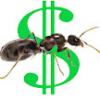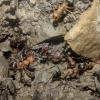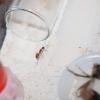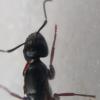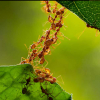First of all, on the reason why we don't release ants, not even natives.
This is from an actual entomologist.
So the reason we don't re-release ants once they've been in captivity is several-fold.
First of all, let's deal with the big thing: if you buy ants from online, they're very unlikely to be local, even if they're the same species. I can buy a Lasius niger from online, which is about as abundant as you can get in the UK, but that doesn't mean I can introduce them locally. The reason for this is that local populations of a given animal have local genetics to that region. Despite being the same species, their traits can differ quite a bit between even local regions, and that, twinned with the fact that eusociality generally results in a low number of individuals within a given area (with colonies being individuals vs actual individual ants), you can seriously disrupt the local balance of genes in a given area, especially as you've released a aet of ants post-founding eliminating natural selection for a large part of their life-cycle.
But let's say you caught your niger queen from your garden, why is it important that you don't re-release? The previous argument actually still holds (you've removed them into a more febrile environment for a part of their lifecycle), but more importantly you're changing the parasitic balance of your local ecosystem.
So what does that mean? Basically, the conditions that you raise your ants in will be very different from the native environment of the ants. As a result, parasites (mites, fungi, bacteria) are way more likely to propagate. It's not a problem for your ants cause they have an abundance of food, clean water etc., but it allows populations of these diseases to propagate in a way they wouldn't have the ability to in the wild.
When you re-release, you can seriously disrupt your local invertebrate ecosystem by introducing your biological-weapon ants on it.
And it gets even worse with invasives, as those usually carry parasites the native ants are not adapted to and that will impact the remaining native ants much harder than they do the invasives that know how to deal with them, allowing invasvie species to further displace the local fauna.
In fact quite often the invasive species themselves aren't even the problem, but their parasites or supporting species are - this is for example true for asian river crabs in Europe, which themselves aren't causing much damage but they act as an intermediate host for a swim bladder worm that has basically already wiped out the european eel (we throw billions of young glass eel into the rivers every year but there's currently no proof that even a single one of them is able to make the journey across the ocean and back).
It is also true for Yellow Crazy ants on Christmas Island although in a reverse way - the ants themselves are a problem but the reason they can grow so out of control and are threatening to exterminate the islands native red crabs is their symbiosis with another invasive insect, an asian lac scale insect. Targeting those scale insects first is actually showing more promise than fighting the ants directly.
And yes, it may take a long time for these "supporting species" to arrive (like with the swim bladder worm which had likely existed in european rivers for decades but was never able to multiply much due to the lack of an intermediate host), but once they arrive they can trigger an absolute disaster.
Your non-native ants may not be a problem now, but you can easily lay an ecological time bomb for future generations to deal with.
Generally ecosystem resilience (the ability of an ecosystem to deal with new species/integrate them or block them out) is a very wide and complex topic. Yes, you can make assumptions on which organisms have a high chance to become problematic invasives, based on certain traits - ants by default tick literally every single box on that list - but you can never really know.
Occasionally you get species that will totally surprise you (like this totally unspectacular european herb i forgot the name of, which when introduced to Hawaii suddenly evolved lignified stems and developed into some kind of 2-3 meter high miniature tree completely taking over steep hillsides and driving out almost every other plant from this specific niche).
Solenopsis invicta - and by extent probably geminata as they are very similar - in many areas is loosing their major caste. This makes their average workers smaller, easier to accidentally be transported from one place to another by humans and even cheaper for an even higher ants-per-area ecosystem domination (and from what i've read Myrmica rubra in Canada is going for smaller workers as well). In areas they have completely taken over they are also becoming increasingly polygynous and have less flights but rely more on budding off fledgling colonies.
Both of these cases are what "phenoytype plasticity" means, the ability to change form to suit new environments/conditions/situations). So technically there isn't even one type of Solenopsis invicta, there are multiple. Solenopsis geminata is likely to follow that path.
Ants are really really good at this phenotype plasticity stuff, many species have multiple worker castes and even the ability to switch them on an off on an evolutionary short timescale. In fact even local populations of the same species are often genetically adapted towards their specific environment.
Ants also have a high dispersal ability, especially species that produce flying alates. A single large ant colony can chug out THOUSANDS of winged queens per year and completely change an ecosystem just by the sheer number of new colonies popping up within a short. Solenopsis invicta in the southern US is like an ecological zerg creeper carpet that advances at a speed of around 30 miles a year and drows out almost the entire native ant fauna under it.
Recently invicta is also adapting to colder climates and can now be fun on sunny hillsides, an area they previously had no access to. I don't think I need to tell you what they're doing with the native ant fauna there.
Then there's also the issue of keystone species - sometimes a predator or parasite decimating a single species central to an ecosystem can change that entire ecosystem and kick off a cascade that completely obliterates existing food chains and most of the species within it. There's an example with sea otters keeping sea urchins in check, which if the sea otters are gone basically eat up the entire plantlife that makes up the sea floor and thus collapses the whole ecosystem but the absolute best example is what happened when yellowjacket wasps got introduced to New Zealand. They didn't exactly wipe out a keystone species but they gobbled up the entirety of the honeydew a single species of the tree bark plantsuckers produced, effectively taking them out of the ecosystem and thus starving out the entire food chain right from the bottom. If nothing had been done New Zealand's woodland ecosystems would not exist today.
I consider Lasius niger a keystone ant species in central european urban and suburban environments. They absolutely dominate most inner city areas and are an effective barrier against most invasive ants, which tend to establish themselves in urban/suburban areas (or generally any area disturbed by human activity) first and then radiate outwards into more "natural" environments. If some introduced parasite wiped out Lasius niger the long-term consequences would most likely be pretty bad - it would open up a gaping ecological hole and most likely some invasive species would quickly fill that micro-size urban scavenger niche.
Some ants have a particular appetite for spiders - Wasmannia auropunctata, the electric ant or little fire ant, which is currently spreading across the pacific, is know to absolutely obliterate local spider populations, which in return completely changes the game for many insects by elminiating one of their top predators. This can then have an impact on the local flora, as insects (like aphids, treehoppers, butterfly larvae, etc.) are the top plant parasites.
And then there's the last thing - time.
Yes, after a certain time every dominant invader will inevitably integrate itself into some sort of functioning ecosystem (or create one around itself, or die out), there is no question about this. The question is how many species had to go extinct to make that happen.
Even if the introduction of an invasive organism results in the complete meltdown and utter destruction of an ecosystem, given a few hundred years a new landscape will emerge and you'll hardly notice the traces of any disaster that took place.
The issue is the old ecosystem - which in case of islands specifically tends to be a very unique one with endemic species that could only be found there and nowhere else in the world - is gone, and it's not coming back.
Most of the species that made it up are lost forever and those that made it may have changed beyond recognition - like the chichlids of Lake Victoria which got absolutely massacred by the intentionally introduced invasive Nil perch, causing species boundaries to break down entirely, resulting a wild array of completely unique new chichlid fish that are slowly establishing themselves into new species at the fringes of an utterly devastated ecosystem. Ironically by now the Nil perch is about to go the way of the Dodo after basically eating up the entirety of the Lake's freshwater fish population, which should send a very clear message to everyone that crap like this just isn't sustainable.
We, as the dominant species on this planet, should strive to preserve its unique ecosystems and not assist in their destruction.
We can still hardly guestimate what the loss of specific species and ecosystems is going to do to our world in the long run, but examples like what happens in Lake Victoria right now should be a dire warning for everyone who thinks "oh yes, this is fine". It may be fine for now, but it may absolutely not be fine in a few decades or centuries.
And given how many of our medical products are derived from different plants, fungi and animals and how much research in these fields depends on new discoveries, preserving the diversity of nature is also clearly in our own self-interest.
![]() At least here I am guilty as charged.
At least here I am guilty as charged.

